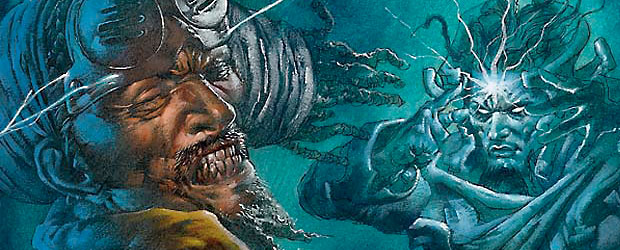By: Houston Whitehead
One evening, after work, I received a text saying, “They’re here. Want to come over?” It was from my future roommate letting me know his dad’s Magic cards from California had arrived. All he told me about was, “They’re f*%&ing old.” That’s more than enough to get me excited to go digging for buried treasure. After picking through the collection I found a few competitive gems, like both Sword of Light and Shadow and Sword of Fire and Ice, but most of the value settles in multiple playsets of Glimpse the Unthinkable and Doubling Season. Keep in mind this was 2013 so Doubling Season was $30+ and Glimpse the Unthinkable was $25 (lower than it is currently).
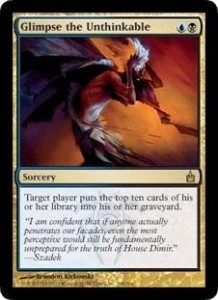 Stacks of other “casual” cards were quickly turning this collection from hundreds to thousands in less than a half an hour. After we finished he said, “I bet you need a lot of this stuff, don’t you.” I replied, “To be honest, just the two swords.” After a confused expression was thrown my way I tried to explain the best I could. “Card value doesn’t always reflect the tournament playability of a card. Sometimes less competitive formats can have just as much demand.“ I talked more about the limited amount of MTG financial knowledge I had and explained the effects of reprints (or lack of), bannings, unbannings, and the varying stability of different formats. It sounds impressive when I list it like that but I promise it wasn’t. I still had a lot to learn as well.
Stacks of other “casual” cards were quickly turning this collection from hundreds to thousands in less than a half an hour. After we finished he said, “I bet you need a lot of this stuff, don’t you.” I replied, “To be honest, just the two swords.” After a confused expression was thrown my way I tried to explain the best I could. “Card value doesn’t always reflect the tournament playability of a card. Sometimes less competitive formats can have just as much demand.“ I talked more about the limited amount of MTG financial knowledge I had and explained the effects of reprints (or lack of), bannings, unbannings, and the varying stability of different formats. It sounds impressive when I list it like that but I promise it wasn’t. I still had a lot to learn as well.
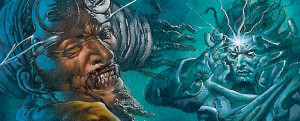
I didn’t give casual card value anymore thought until I started working at my LGS. Valuable Commander cards and casual cards many times overlap, but the growth of Commander was starting to apply more pressure on our inventory. I made or filled up all the $1, $2, and $3 binders with these styles of cards and had a hard time keeping a few cards in stock. I went even deeper by placing cards like Dream Twist in the case for .50 next to Traumatize and Mind Funeral. This experiment also brought some success.
Themes
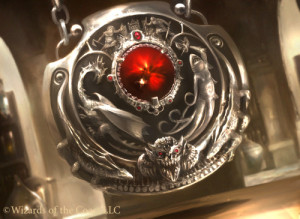 Last week I thought about what qualifies a casual card. The closest place to find kitchen table decklists is TappedOut but we don’t have a place to see how those players deckbuild. It’s doubtful they have trends and meta changes cause every kitchen table is different. Most of the time you play with what you opened in packs and buy a few more to make it a little sweeter. I wanted to find a way to find those extra cards. Single sales is probably the best way to determine but I don’t have access to online retailer’s sales statistics. Closest thing I thought of was buylists. When I was at GP Nashville I saw “Quicksilver Amulet” for $3 on a buylist. I had a bunch in a box at home but never thought adding them to my backpack for the day would make me money.
Last week I thought about what qualifies a casual card. The closest place to find kitchen table decklists is TappedOut but we don’t have a place to see how those players deckbuild. It’s doubtful they have trends and meta changes cause every kitchen table is different. Most of the time you play with what you opened in packs and buy a few more to make it a little sweeter. I wanted to find a way to find those extra cards. Single sales is probably the best way to determine but I don’t have access to online retailer’s sales statistics. Closest thing I thought of was buylists. When I was at GP Nashville I saw “Quicksilver Amulet” for $3 on a buylist. I had a bunch in a box at home but never thought adding them to my backpack for the day would make me money.
Any financier understands the value of a buylist but I doubt that will unlock all the casual desirable since each inventory varies by retailer. So, I attempted to breakdown each theme that qualifies a potential gainer inside the casual market.
*Keep in mind these strategies can overlap but are predominantly satisfy one type of theme*
Committed Themes – Cards that are good at one thing and help achieve a basic/simple goal. These decks are built with cards that revolve around this commitment.
-
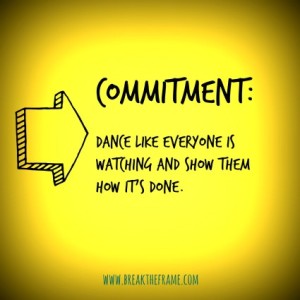
Art credit to Breaktheframe.com Lifegain – Gain life until to you make a 10 min. game into a 5 hour game.
- Mill – Forcing your library into your graveyard until you can’t draw a card.
- Burn – Cheap spells that deal damage
- Douchbaggary – Strategies that deny your opponent the ability to play Magic.
- Land Destruction – You can figure this one out.
- All Counters – Counter everything you play without having a game plan to actually win the game.
- Over Taxing – Effects, permanents, or creatures that make casting spells cost an additional amount of mana or require paying mana to allow your creatures to attack.
Synergistic Themes – Cards that require assistance from other cards to achieve a more complex goal.
-

Art credit to Skyline.org Tribal – Any card that cares about a creature type. Goblins, merfolk, and elves, Lorwyn Block, slivers, wizards, rebels, etc. Usually involve “lords” that grant abilities or extra power and toughness while they are on the battlefield.
- Combo – Usually three card infinite combos or combos that do creative but not game-winning things. Ex: Soul’s Attendant + Leonin Relic-Warder + Phyrexian Metamorph = Infinite Life
- Tokens – Creating a wide token army combined with equipment or enchantments with “lord” effects.
- Alternative Win Con – Winning without reducing your opponents life total or milling until they cannot raw cards. Ex: Helix Pinnacle
- Counters (the non-blue kind) – Placing a large amount of +1/+1 counters on your creatures or -1/-1 counters on your opponents creatures. Also includes effects to increase the amount of counters or give abilities to creatures with counters on them. Ex: Doubling Season
Identifying the most popular archetypes was my first step in identifying the casual cards with the most gain potential. Desired commons and uncommons can hold foil value like the Foil Invasion Heroes’ Reunion ($2.50) or Foil Hedron Crab ($8). These are prices an everyday player or store might not be aware of. Sadly, gaining value on casual cards takes patience but at least they’re the easiest to pick up. Adding potential casual cards to your mental list of cards to pick from collections, might surprise your wallet later. I actually have a thousand count box to place these investments in. My Non-Standard binder isn’t shy of casuals like Isochron Scepter and Browbeat either. I practice what I preach.
In Casual Gains #2: Identify, I’ll talk more about specific cards and prices inside each theme.
As always thanks for reading
